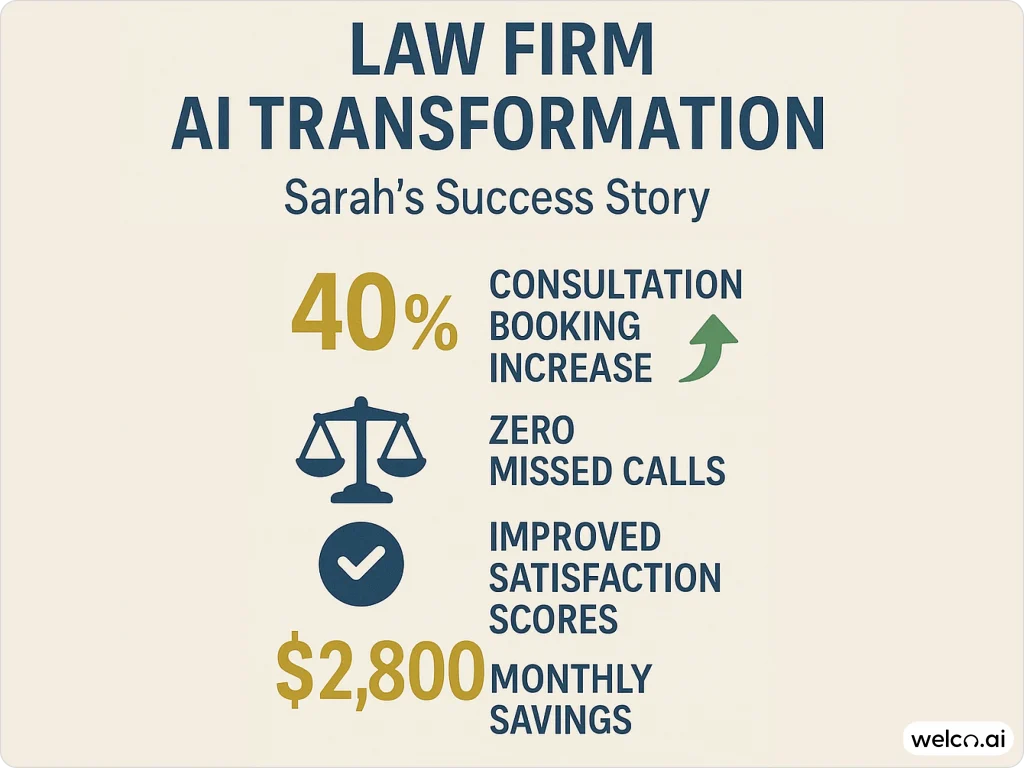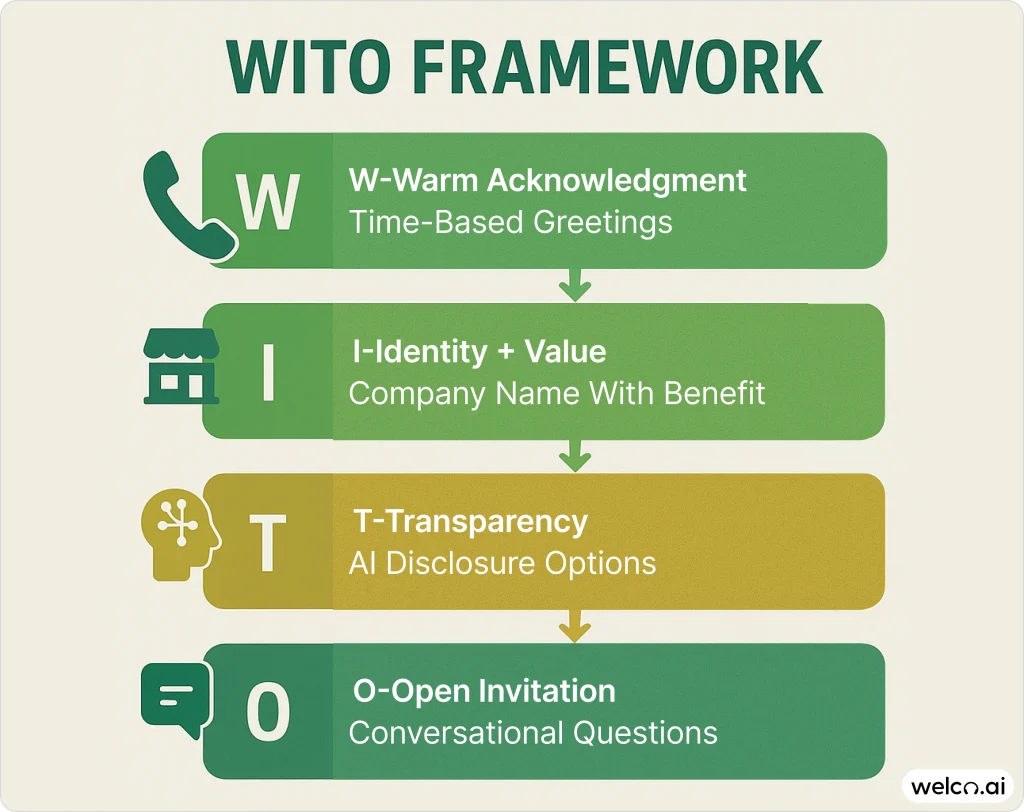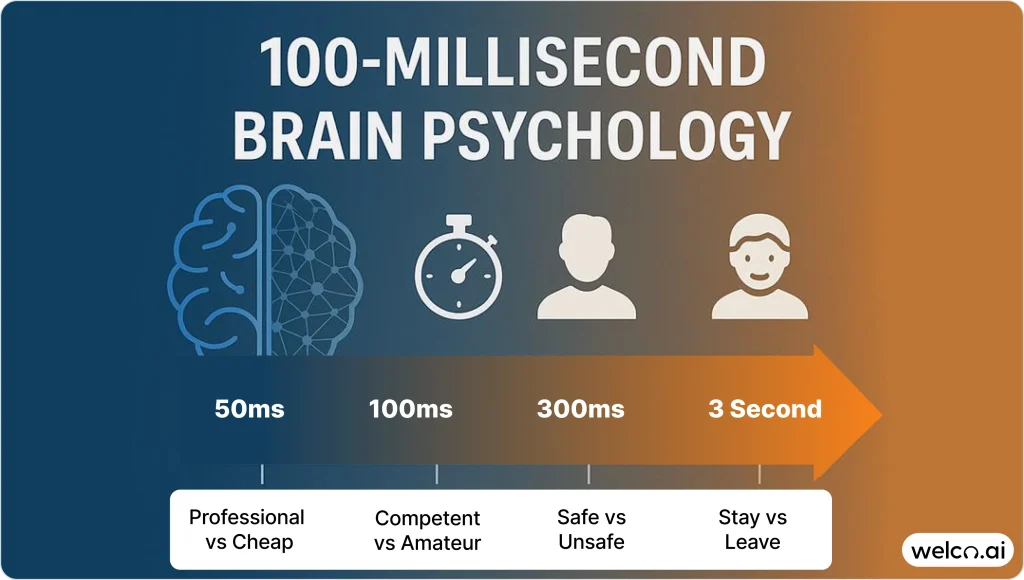The Make-or-Break Moment
Picture this: Your phone rings. A potential client is calling, ready to spend thousands on your services. But within seconds of that first interaction with your virtual receptionist, they’ve mentally moved on to your competitor.
This scenario plays out thousands of times daily across businesses everywhere. You know you’re losing prospects, but you can’t pinpoint exactly why. The frustration is real—your credentials are solid, your prices competitive, yet somehow the magic just isn’t happening in those crucial first impression moments.
Here’s what most business owners don’t realize: Princeton University research reveals that customers form complete trust judgments in just 100 milliseconds of first contact. Within that blink of an eye—faster than conscious thought—potential clients decide whether your business communication is professional, competent, and worth their time.
While this guide focuses on AI receptionists, these first impression psychology principles apply to any first phone interaction—whether it’s handled by AI, human staff, or automated phone systems.
Consider Sarah, a typical law firm owner who faced exactly this problem. Her practice had everything going for it: experienced attorneys, stellar client reviews, competitive rates. Yet prospects calling her office rarely converted to consultations. They’d sound interested initially, then ask to “think about it” or simply hang up without scheduling appointments.
The pattern was devastating: qualified leads were slipping away in those critical first 10 seconds, representing thousands in lost revenue and years of potential client relationships.
After optimizing her customer first impressions with an AI receptionist, Sarah’s transformation was remarkable:

- Consultation booking rate increased by 40%
- Zero missed calls during her busiest court days
- Client satisfaction scores improved across the board
- Monthly savings of $2,800 while dramatically improving professional phone answering quality
Sarah’s breakthrough wasn’t just implementing technology—it was understanding the business psychology behind those make-or-break first moments. For businesses looking to implement comprehensive 24/7 customer service optimization strategies, the first impression foundation is crucial for success.
The WITO Framework: What Works Immediately
After analyzing successful professional first impressions across industries, the highest-performing AI receptionists follow this structure:

W – Warm Acknowledgment
Use time-based greetings like “Good morning!” instead of generic “Hello”
I – Identity + Value
State your company name with a hint of your unique benefit
T – Transparency
Optional AI disclosure based on your customer demographics
O – Open Invitation
Use conversational questions like “What brings you to us today?”
Example: “Good morning! Thank you for calling Wilson & Associates, where we protect what matters most to you. I’m here to help—what brings you to us today?”
Why This Call Handling Framework Works
Compare this to a typical greeting: “Hello, this is ABC Law Firm. How can I help you?”
The generic version offers no warmth, provides no value proposition, and uses a closed question that can feel intimidating. The WITO approach immediately signals warmth, establishes value, and invites natural customer engagement.
The 100-Millisecond Customer Psychology
When someone calls your business, something fascinating happens in their brain through behavioral economics. Before they can even consciously process what they’re hearing, their subconscious is making critical judgments:
In the first 50 milliseconds—before you can even register what you’re hearing—your caller’s brain is already deciding if your business phone service sounds professional or cheap.
By 100 milliseconds—still faster than conscious thought—they’ve evaluated your competence through trust building psychology. Professional or amateur? Trustworthy or questionable?
Within 300 milliseconds, the emotional safety check is complete. Do they feel welcomed, or does something feel off?

By 3 seconds, the customer decision psychology is made. Stay on the line, or hang up and try someone else?
This isn’t theory—it’s hard consumer behavior psychology. Everything that happens after those first 100 milliseconds is either reinforcing or desperately fighting against a judgment that’s already been made.
The Technical Reality
Here’s the critical factor most businesses overlook: premium AI voice technology sounds natural and professional, while budget alternatives immediately signal “cheap automation.” This difference is noticeable within the first few words—you can have the perfect script, but if your AI phone system sounds robotic, you’ve already lost the psychological battle.
The Generational Trust Factor
Your customer experience strategy must account for different comfort levels:
- Under 35: Generally comfortable with AI customer service interactions
- 35-55: Prefer transparency about AI with human alternatives available
- Over 55: Often initially uncomfortable but respond well to clear AI disclosure
When virtual answering services transparently identify themselves while offering human alternatives, customer satisfaction improves across all age groups. Understanding personalization in automated customer interactions becomes crucial for creating authentic connections that transcend generational preferences.
Key Applications by Industry
Healthcare practices face callers who are often stressed or in pain, requiring greetings that convey both clinical competence and genuine compassion: “Good morning, thank you for calling Westside Family Practice. I understand health concerns can’t wait—how can I help you right away?”
Legal services deal with callers facing serious problems who need immediate reassurance about confidentiality: “Welcome to Wilson Legal. All calls are strictly confidential. I understand you’re seeking legal guidance—let me connect you with the right attorney for your specific situation.” The word “confidential” in the first 10 seconds transforms guarded prospects into engaged potential clients. This principle extends beyond scripting to comprehensive voice brand identity development that aligns every interaction with your firm’s professional image.
Common First Impression Killers
Avoid these trust-destroying responses:
- “I don’t know” → Use: “Let me find the right specialist”
- “You’ll need to…” → Use: “I can help you…”
- Generic “How can I help?” → Use: “What brings you to us today?”
Technical failures that destroy trust:
- Slow response times that create awkward pauses
- Robotic voice quality signaling cheap automation
- Scripted responses that feel machine-like
- No escalation protocols for confused customers
Understanding call routing psychology helps prevent these common failures by designing systems that work with human psychology rather than against it.
Getting Started: Your 4-Week Implementation
Week 1: Audit Current Performance
Record 20-30 incoming calls and note:
- Response time to first greeting
- Caller reactions and engagement levels
- Current conversion rates
Week 2: Design Your Professional Greeting Script
Apply the WITO framework to your specific business context and test variations.
Week 3: Optimize AI Voice Technology Performance
Focus on voice selection, response times, and quality testing across your business phone solutions.
Week 4: Add Emotional Intelligence
Develop protocols for stressed callers, urgent situations, and repeat customers. For businesses dealing with particularly sensitive inquiries, learning how to manage complex customer interactions becomes essential for maintaining first impression quality throughout challenging conversations.
What to Expect from AI Receptionist ROI
Most businesses implementing optimized AI receptionists see:
- Improved conversion rates within the first month
- Better customer satisfaction scores
- Reduced missed calls and follow-up requirements
- ROI typically achieved within 3-6 months
For organizations serving diverse communities, implementing multilingual AI capabilities can significantly amplify these results by ensuring positive first impressions across all customer demographics.
The key isn’t perfection—it’s understanding that professional first impressions aren’t accidents. They result from deliberately crafting every element of initial contact for maximum psychological impact.
A Cautionary Example: AI Implementation Failures
Here’s a composite of what we’ve seen happen when first impressions go wrong:
A mid-sized legal firm decided to implement an AI receptionist to handle their growing call volume. But they rushed the setup, and within two weeks, they were facing a crisis:
Their AI phone system couldn’t distinguish between different practice areas—routing clients to completely wrong attorneys. The voice AI sounded so robotic that long-term clients started questioning the firm’s stability. When confused callers asked for clarification, there was no escalation protocol—they just received more confusing responses.
The breaking point came when an important prospective client called about a time-sensitive matter and was transferred multiple times before hanging up in frustration. They hired a competitor the same day.
The firm switched back to their old system within a month, but the damage was done. They’d lost several potential clients and shaken existing client confidence.
The lesson? First impressions can work powerfully for you or devastatingly against you—they’re never neutral. This case illustrates why many organizations experience AI implementation failures when they focus on technology deployment rather than strategic customer experience design.
Your Next Steps
Here’s the reality: Every day you delay optimizing your first impressions, you’re losing potential customers to competitors who understand this customer psychology.
The science is clear—customers form trust judgments in 100 milliseconds. The WITO framework gives you a proven structure for winning those critical moments. The AI receptionist implementation process delivers measurable results that compound over time.
But here’s what matters most: The next prospect who calls your business phone service will form their judgment in 100 milliseconds. What first impression will they get?
Don’t let another qualified lead slip away in those make-or-break first moments. Start by recording a few of your current incoming calls and honestly assess the experience from a prospect’s perspective. You might discover that fixing your customer first impressions is the fastest way to grow your business.
The business transformation begins with your very next call.
Frequently Asked Questions
My current receptionist sounds friendly enough. How do I know if our first impressions are actually costing us business?
Record 20-30 incoming calls and listen for these warning signs: long pauses before answering, generic greetings that don’t mention your value proposition, callers asking “What do you do?” or “How are you different?” If you’re hearing these patterns, you’re likely losing prospects in those critical first moments. The easiest test: call your own business phone service as if you’re a prospect and honestly assess how you feel about the interaction.
I’m worried our customers will hate talking to an AI. How do I handle the inevitable complaints?
Start with after-hours coverage where customers are grateful to reach anyone instead of voicemail. Most resistance comes from poor AI implementation, not AI itself. The key is transparent AI disclosure: “I’m an AI assistant here to help connect you with the right person. Would you prefer to speak directly with someone on our team?” This approach respects preferences while demonstrating competence.
We tried an automated phone system before and it was a disaster. How is this different?
Traditional phone trees and basic chatbots are completely different from first impression-optimized AI systems. The disasters happen when businesses use rigid, rule-based systems that can’t handle natural conversation. Modern AI understands context, adapts to caller emotions, and seamlessly escalates to humans when needed. The difference is like comparing a flip phone to a smartphone.
What if our AI says something wrong or gives incorrect information about our services?
This is exactly why proper setup matters. Quality AI voice systems include confidence scoring and automatic escalation when they’re uncertain. Train your virtual receptionist on your specific services, pricing, and policies during AI implementation. Most importantly, set clear boundaries—never let AI handle pricing discussions or make commitments beyond basic information gathering and appointment scheduling.
How much will this really cost, and what if it doesn’t work for our specific business?
Quality first impression optimization typically costs $8,000-$15,000 for initial setup, then $200-$500 monthly depending on call volume. Most businesses see payback within 3-6 months through improved conversion rates and reduced staffing needs. The bigger risk is continuing to lose prospects with poor first impressions—that costs far more than the investment in fixing the problem.
Our business is very specialized with complex technical terminology. Can AI really handle our specific industry jargon?
Yes, but only with proper training. AI phone systems can learn industry-specific terminology, but you need to invest time upfront teaching the system your vocabulary, common scenarios, and escalation points. The Johnson & Associates example shows what happens when you skip this step. Budget extra time for specialized industries like legal, medical, or technical services.
